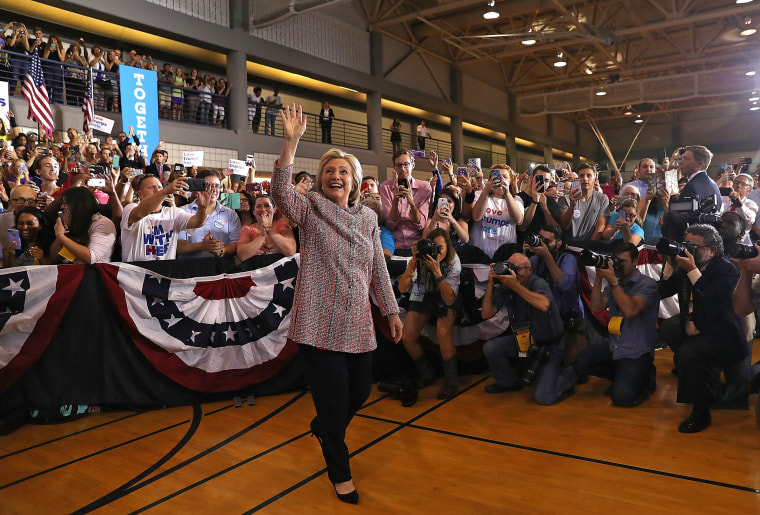New polls released this week suggests Hillary Clinton has a growing problem with millennial voters and that's a major concern for the Democratic presidential nominee.
Both national polls and surveys in swing states show Clinton has seen a slide with voters younger than 35, particularly when Libertarian candidate Gary Johnson and Green Party candidate Jill Stein are factored in.
- A national Quinnipiac poll showed Clinton capturing 31% of the vote among voters 18-to-34 years of age and a slim 5-point lead over Trump. In August Clinton had 48% of that vote and a 24-point lead over Trump.
- A Fox News poll of the national electorate showed Clinton winning 37% of the youth vote and leading Donald Trump by 9 points. In August, the poll showed her support at 39% and leading Trump by 8 points.
- In Ohio, a CBS/YouGov poll showed Clinton doing better with voters under 30, winning 51% of them and holding 32-point lead on Trump. But that number was down from August when Clinton won 57% of that vote and a held a 38-point lead.
- A Detroit Free Press poll in Michigan showed a big dip among voters under 35. In the new poll she has 31% of that vote and a 7-point lead over Trump. In August she had 44% of that vote and a 24-point lead.
The lower numbers are a big problem for Clinton because Democrats need a lot of votes from the younger part of the electorate to offset losses they normally get with older voters. Consider 2012 when Millennials gave President Barack Obama his biggest numbers by far. He captured 60% of the under-30 vote in the national electorate, compared to just 37% that went for GOP nominee Mitt Romney.
Obama did even better with that age group in Michigan and Ohio with 63% of the under-30 vote.




It's an issue Obama himself addressed in his campaign appearance in Philadelphia last Tuesday. In trying to rally the coalition that elected him twice to get enthusiastic about backing Clinton, the president took a moment to address young voters:
“And the young people who are here, who all you’ve been seeing is just the nonsense that’s been on TV, you maybe don’t remember all the work that she has had to do and all the things she has had to overcome and all the good that has happened because of her efforts. But you need to remember. ... She’s in the arena and you can’t leave her in there by herself, you’ve to get in there with her. You can’t stay home because, you know, she’s been around for a long time. Well you know what? This is not reality TV. Democracy is not a spectator sport. You don’t Tweet in your vote.”
First Lady Michelle Obama also hit the campaign trail last week, speaking at a rally at George Mason University in Virginia. "Let’s be clear, elections are not just about who votes, but who does not vote," she told the students. "And that is especially true for young people, like all of you. In fact, in 2012, voters under the age of 30 provided the margin of victory for Barack in four key battleground states."
So where is Clinton’s Millennial vote going? It depends on the poll you examine. Some of it is going to Trump and some to the undecided or "other" categories. But third party candidates seem to be playing an outsized role in 2016.
In the national Fox News and Ohio state polls. Libertarian Gary Johnson has seen small increases among Millennials since August, 2 points and 5 points respectively. In those polls Johnson sits at about 17% of the vote.
In the national Quinnipiac and Michigan state polls, the Johnson gains among young voters are much more substantial, 13 points and 14 points respectively. He’s now garnering about a quarter of the vote in those polls.
In a close election those could be big numbers and they say a lot about the 2016 campaign. In a year full of strange wrinkles in the campaign, Mr. Johnson is not new. He ran in 2012 as well, as did Green Party candidate Jill Stein, but with very small impacts.
In 2012 the Johnson and Stein together garnered about 1.5% of the vote. Even among voters under the age of 30 they didn’t rack up big numbers. Exit polls show that Mr. Obama and Republican Mitt Romney together captured 97% of the 29-and-younger vote. That means Johnson, Stein and all other votes were a mere 3% of the younger voter tally.
But as the poll numbers above show, 2016 may be shaping up to be very different.
The question behind Clinton’s millennial dip is whether it represents a moment in time or a new norm. If the presidential race stays close, will younger voters decide to vote for one of the two major party candidates, go with a third-party option or stay home?
On that point, some of the key locales to watch in the coming months are communities with large pockets of Millennial voters, the nation’s college counties. Think of Dane County, Wisconsin, and Washtenaw County Michigan, the homes of the Universities of Wisconsin and Michigan respectively.
It’s fall, classes are back in session and the poll numbers suggest Clinton and other campaign surrogates may be logging some campus time in the coming weeks.
